Author: David Han, David Duong, Coinbase; Translator: Deng Tong, Golden Finance
Abstract
Agent-based AI has emerged as one of the most promising narratives in the AI x crypto space, but the field is still in its infancy and difficult to navigate due to the rapid development of the technology and the massive proliferation of agents.
Investor interest in AI agents is primarily reflected in two areas - the core infrastructure for launching and hosting agents, and the individual agents themselves.
We believe that the field of agent-based AI in crypto has huge room for future growth as its functionality continues to enrich. However, at least for now, expectations for AI agents may outpace the development of the technology itself.
AI agents have become a revolutionary theme not only in the crypto space, but also in the broader technology space. The concept of autonomous entities that can analyze market news feeds or other external data and make real-time decisions has captured the imagination of many institutional investors. Elsewhere, some tech industry leaders believe that agent AI could eventually replace the massive software-as-a-service (SaaS) industry. That is, well-trained AI agents could, in principle, complete any task involving a digital interface. We believe that crypto rails could play a central role in the future as the primary value transfer mechanism for AI agents. Crypto’s inherently programmatic nature and permissionless design support the scaling and deployment of a virtually unlimited number of such agents, enabling a wider range of use cases from managing on-chain portfolios to paying for off-chain services. Given this potential opportunity, the market capitalization of agent AI crypto assets peaked at over $20 billion in early January before approaching $8 billion by the end of the month.
The recent drop may indicate that expectations for AI agents have begun to outpace actual developments in the technology itself. While we expect this theme to transform the crypto x AI landscape in the long term, its near-term applications are limited by integration and agent differentiation challenges, as well as unclear long-term utility for agent tokens. In other words, realizing the full potential of AI agents may take longer than many imagine.
Understanding the Difference: Agents vs. Models
Many popular AI tools, including chat interfaces like ChatGPT or image generators like Stable Diffusion, are wrappers around generative AI models. They are defined by a bounded set of inputs and outputs, typically in the form of text, audio, and images. AI agents extend the immediate capabilities of these models by introducing a new class of applications that represent a “combination of reasoning, logic, and access to external information” (as defined by Google).
Specifically, AI agents can access and interact with a wider range of data and tools, allowing them to drive more complex behaviors, from searching multiple databases to planning trips and booking flights. With on-chain wallet integration, the scope of AI agent activities is greatly expanded by incorporating payment services into their toolkit.
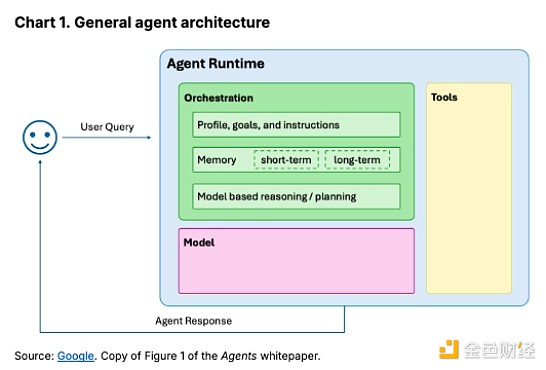
Critically, AI agents can also use their reasoning capabilities to act autonomously in dynamic environments. Triggers for AI agents are not limited to manual user prompts - they can be concurrently based on a variety of data streams, including X (formerly Twitter) posts or Twitch chats. Likewise, their responses can include multi-step outputs, such as placing an order, making a payment, and sending a confirmation to the interested party.
Agents are typically composed of (1) a core LLM model as their inference engine, (2) short-term and long-term memory components, (3) a potential persona or personality framework, and (4) most importantly, the ability to access the wider internet and other tools through application programming interfaces (APIs). As a result, the decisions made by the agent can directly impact the real world.
AI Agents Are Exploding
The infrastructure and tooling around AI agents is evolving rapidly, becoming one of the most talked-about technology trends of the past year. Multiple developer frameworks for building AI agents (including but not limited to CrewAI, LangGraph, AutoGen, phidata, Atomic Agents, AgentGPT, and AutoGPT) are vying for market adoption, and the top 15 code repositories on Github in January 2025 are all related to AI.
The attention and excitement around AI and its agent applications has carried over to AI-related tokens in crypto. Much of the recent growth in token value since Q4 2024 is related to the agent AI theme, which now accounts for 29% of the value of all AI-related crypto tokens. Within the agent AI ecosystem, agent tokens account for the majority of valuation, accounting for $4.5 billion in market cap, while tokens related to launchpads and frameworks have a market cap of $2.9 billion, according to cookie.fun, a platform that tracks AI agents within the crypto space.
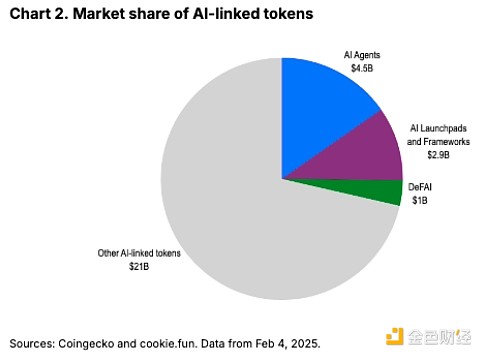
We believe that the outsized attention paid to proxies relative to their underlying infrastructure is driven in part by the memetic nature of many “proxies” relative to their underlying infrastructure, which coincides with the increased memecoin activity observed throughout much of 2024. In fact, one of the first AI-related tokens to achieve virality became famous because it was endorsed by the AI agent operating the famous X-account truth_terminal (now with over 250,000 followers), rather than having an underlying project or governance structure associated with it.
That said, some AI agent tokens offer more utility by granting access to token-gated chat terminals or services where agents can provide differentiated perspectives on various topics, such as the state of the crypto market. Meanwhile, in our view, AI infrastructure tokens tend to be more project-specific based on revenue, often used to pay fees and governance.
To date, most AI agents, launchpads, and other infrastructure have found their home on high-throughput and low-cost blockchains — particularly Solana and Base. Solana accounts for $4.2 billion of the proxy AI token market cap, Base accounts for $3 billion, and the remaining chains account for $1.5 billion of the market cap combined. We believe this is in part because low-cost architectures are necessary to support widespread adoption of AI agents. Additionally, we believe that the strong developer ecosystems that have formed on the leading chains drive a virtuous cycle of mindshare and adoption.
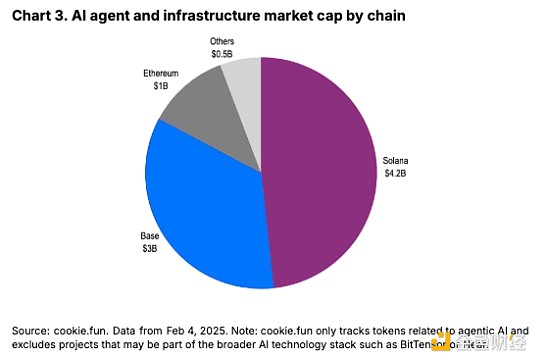
Fighting for Investor Mindshare: Social Influence
The current agent AI space has several leading agents that have begun to dominate the field. The most prominent AI agent to date, aixbt, gained attention by operating an X account (now with over 465K followers) that is dedicated to interacting with the crypto audience on the platform. It has a token-gated terminal where users who hold a sufficient number of project tokens can access a dedicated chat space with the agent, giving them private access to their real-time "thoughts".
Other leading agents, such as zerebro (with 119K followers), have followed a similar model to gain attention in the space through prominent social media profiles. Zerebro is specifically focused on on-chain art generation. Its native token can be used to pay for the creation of images, while its chat terminals are controlled by NFTs.
However, not all agent AI tokens have the appearance of utility. One of the top AI tokens by attention (tracked by cookie.fun) is Fartcoin, the idea for which was conceived through conversations with the aforementioned truth_terminal AI agent. That said, the origins of the token itself are tied to AI agents, though the long-term utility of the token itself beyond memetic importance remains unclear.
We believe that the interplay between memes and the token utility of AI agents has attracted traders from all walks of life, from speculators to value investors. That being said, given the rapid pace of development in the space, we believe the ultimate scope and capacity of any individual token remains largely unknown. That said, it remains an open question as to whether AI agent-related memecoins will evolve beyond pure speculation and/or demonstrate any utility beyond community governance or access gating. We discuss this further in the Risks and Future section below. Following the Money: Launchpads and Infrastructure After being one of the best performing crypto sectors in November and December 2024, AI agent tokens took a notable hit in January 2025, in part because the market became heavily saturated in such a short period of time. This led to some market consolidation. As many of these tokens compete directly with memecoins in the cryptocurrency attention economy, it remains difficult to project value accretion in this space. In the near term, we find that direct protocol revenues tend to be concentrated in trading interfaces and launchpads where AI agent tokens are deployed, rather than the tokens themselves, despite their relatively small aggregate market cap.
On Base, Virtuals Protocol has been the leading AI launch platform, enabling streamlined launches of AI agents and tokens in gaming and various application areas. (Note: Virtuals announced its expansion to Solana on January 25.) Virtuals agents can be created without any coding. Users simply fill out a simple form and spend the required number of Virtuals platform tokens. Upon submission, a Baseline agent is initialized on the Virtuals infrastructure, while the associated token is minted on-chain. Initially, tokens are deployed in a bonding curve and then rolled over to a Uniswap pool once a certain liquidity threshold is reached. (Note: this has some similarities to the token launch on pump.fun and its rollover to the Raydium pool.)
To date, nearly 16,000 agent tokens have been launched on Virtuals, generating over 20 million Virtuals tokens for fees. That being said, the number of agents launched has decreased over the past few weeks, dropping from a peak of 1,181 in one day to an average of 31 in the last week of January. Additionally, the number of tokens with sufficient liquidity has dropped to an average of one to two per day. Overall, only 334 (2%) of the 15,985 tokens launched have achieved sufficient liquidity to move to the Uniswap pool, indicating that competition for attention and capital is intense.
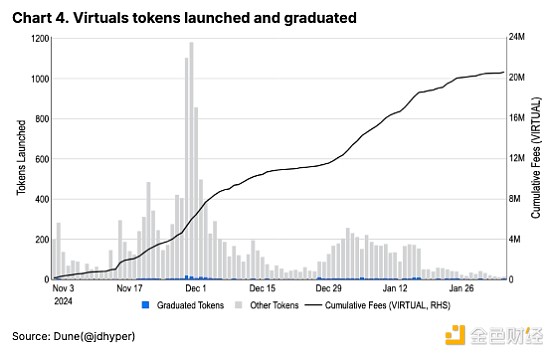
We believe the main reason for this decline is the difficulty in creating new agents that are sufficiently different from existing agents. While Virtuals agents can be customized in their cognitive, voice, and visual cores, parsing the variations between agents launched on Virtuals has become an increasingly difficult task - mirroring mindshare competition such as memecoins. Nonetheless, we believe that as AI agent integrations expand and use cases are further explored, launchpads like Virtuals will play a key role in the proliferation of agents in this ecosystem. In fact, the aforementioned aixbt was launched on Virtuals.
The main alternative to the Virtuals launchpad is the ElizaOS agent framework. Unlike the streamlined deployment of mature launchpads, agent developer frameworks like ElizaOS only provide the technical scaffolding required for agent building. That said, more technically inclined agent creators can use ElizaOS to launch highly customized agents on different blockchain networks, as model hosting, validation, and other engineering tasks are left to the creator. That being said, AI agent hosting companies like Fleek also support code-free deployment of ElizaOS-based models.
As a pure AI agent development framework, ElizaOS does not have a native token. However, the ai16z governance token on Solana (now rebranded as the ElizaOS token) is often seen as a proxy for adoption of the technology, as the creator of the ai16z decentralized autonomous organization (DAO), Shaw Walters, is the founder of Eliza Labs, which oversees the development of ElizaOS. The ai16z DAO itself manages investments both on-chain and off-chain, and AI fund managers (built using the ElizaOS framework) manage trading and positioning.
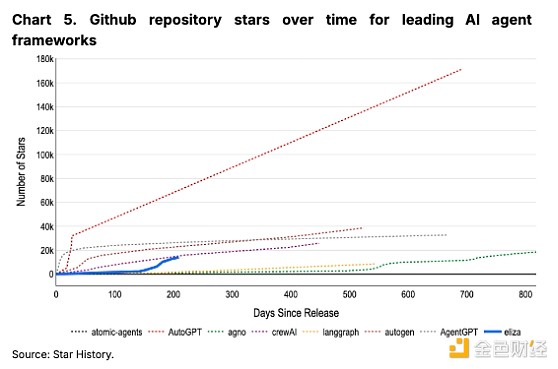
The ElizaOS framework in particular has received a lot of attention since its release, with its codebase at one point becoming the most popular repository on Github. If a developer feels a project is particularly influential, they can choose to “star” the repository, much like liking a photo or post on social media. The number of stars ElizaOS has received makes it quite competitive with many other leading AI agent frameworks, including those launched by tech giants such as Microsoft. (See Figure 3.) We believe this indicates that the broader software engineering community has a real interest in the intersection of AI agents and on-chain activities, which is a core differentiating feature of ElizaOS as an AI agent framework.
In addition to Virtuals and Eliza, many other AI agent frameworks and launchpads have surfaced and found their own niches. For example, Griffain aims to create an agent network tailored for DeFi activities. Meanwhile, the Arc agent framework is differentiating in that, in addition to being built in Rust, it is designed to be more lightweight and modular. We expect this space to grow rapidly as these frameworks evolve and new ones are adopted.
Risks and the Future
Alternatively, we believe that the pullback in AI agent performance in January could signal an early maturation of the industry as more capital flows begin to shift toward DeFAI (decentralized finance + AI) and/or other infrastructure.
DeFAI represents the marriage of AI and crypto to enhance various DeFi capabilities. The benefits include the ability to run automated yield farming strategies, using predictive algorithms for better risk management and fraud prevention. As many DeFi protocols begin to ossify, the integration of AI capabilities with the existing ecosystem can drive new innovation. Over time, the industry is expected to foster new financial products and scale many DeFi platforms by using the computing power of AI.
At this point, however, the long-term utility of AI agent tokens beyond gatekeeping access and facilitating governance is unclear. The reality is that while AI agents have made significant progress very quickly, we are not yet at the point where fully autonomous AI agents can handle complex real-world tasks without any supervision. Their current reliability remains limited and their costs remain prohibitively high. Many AI agents also fail to consistently handle data validation issues, which could raise legal issues or affect user confidence.
Nevertheless, continued breakthroughs like the emergence of the DeepSeek R1 model—which itself focuses on high-level “reasoning” tasks—could upend concerns about the speed-to-cost ratio. In fact, these models are advancing so rapidly that accounting firm Deloitte predicts that within two years, half of all companies currently using generative AI could have launched AI agents.
Ultimately, the transformative vision is that we may have a multi-agent system where autonomous AI agents strategically cooperate and/or compete to optimize more complex outcomes than is currently possible. The nascency of the field makes predictions challenging, though. Furthermore, large tech companies like OpenAI have only recently begun releasing their early AI agents, and we expect more to follow soon. The development of centrally hosted AI agents — potentially integrated into traditional payment rails — could also be disruptive to the adoption of on-chain AI agents. We believe that development in this space will be extremely dependent on first movers and early adoption flywheels.
Conclusion
Agentic AI has been one of the most talked about topics in terms of both interest and trading opportunities among liquidity tokens over the past few months. While valuations for many major tokens have fallen significantly from their all-time highs (as witnessed in early January), we believe that developer interest and capital inflows into the space could provide a significant tailwind for the industry in the long run.
But at the same time, we believe that it may be premature to make predictions about the long-term value capture of AI tokens due to the potential for disruption to the space from both cryptocurrencies and the broader technology landscape. Furthermore, we believe that the current on-chain utility of agents may not be sufficient to warrant having thousands of agents with high usage in the near term. Nevertheless, we believe that the space remains an important theme to watch due to the rapid pace of innovation and the high long-term potential.
 Hui Xin
Hui Xin
 Hui Xin
Hui Xin Clement
Clement Catherine
Catherine Kikyo
Kikyo Brian
Brian Catherine
Catherine Davin
Davin Jasper
Jasper Aaron
Aaron Jasper
Jasper